Bike
Commuting

After
feeling the effects of gas prices and seeing the economy crater, I decided I'd
like to see what it would be like to
get around the SF Bay Area without a car. In other words, to commute via bike +
train. I figured it might be a good way to save up some money for Christmas
while getting into better cycling shape. And, more importantly, see how folks
get around when they’re tied to someone else’s schedule. What I l experienced was very
interesting.
Cost
Caltrain is the train system that runs between San Francisco and San Jose. Round
trip rates vary depending on distance, but for my route it’s $7.60/day--a bit
more than I was expecting (of note, for the 4 weeks I did this, I was only asked
to show my ticket 4 times). Driving is 60 miles round trip and I get around 15
mpg. At $4/gallon, that’s $20 in gas; at the current $2/gallon, it’s 10$ in gas
per day. So it
is a small savings. Driving takes about 30 minutes while the train takes 30 plus
60 for the bike plus 10 for the shower at work.
Bottom line: $2.50 in savings
per day with an extra 70 minutes of commute time. Note: I blew through any savings
by buying additional equipment.
My commute
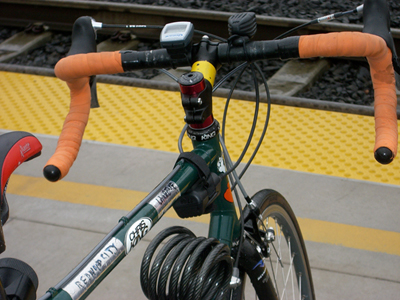 I
live at the top of a hill. The descent is about 400 feet in elevation, most of
which happens within ¼ mile. It’s a thrilling ride with only one short climb
from my house to the train station that’s just over 3 miles away. I can make it
in 12 minutes. Depending on where I get off, it’s an additional 3 or 7 miles
ride to work. Unfortunately, the drop off closest to work doesn’t have frequent
stops, so dropping off at a place farther North provides more flexibility though
longer cycling distance.
I
live at the top of a hill. The descent is about 400 feet in elevation, most of
which happens within ¼ mile. It’s a thrilling ride with only one short climb
from my house to the train station that’s just over 3 miles away. I can make it
in 12 minutes. Depending on where I get off, it’s an additional 3 or 7 miles
ride to work. Unfortunately, the drop off closest to work doesn’t have frequent
stops, so dropping off at a place farther North provides more flexibility though
longer cycling distance.
Day 1
I nervously arrived at the train station “on time” and boarded the train.
Fortunately, I had ridden the train with the bike a few times before and figured
out how to label my bike for on/off locations in advance. Labeling with on/off
stickers is critical!
Unfortunately, I had inadvertently got the EARLIER train, which dropped me one stop South of my intended location. Using my crackberry, I roughly figured out where I was and how to get to work. Doesn’t seem like a big deal, but when you’re faced with driving on unfamiliar roads with lots of traffic, it can be overwhelming.
The Orchestra
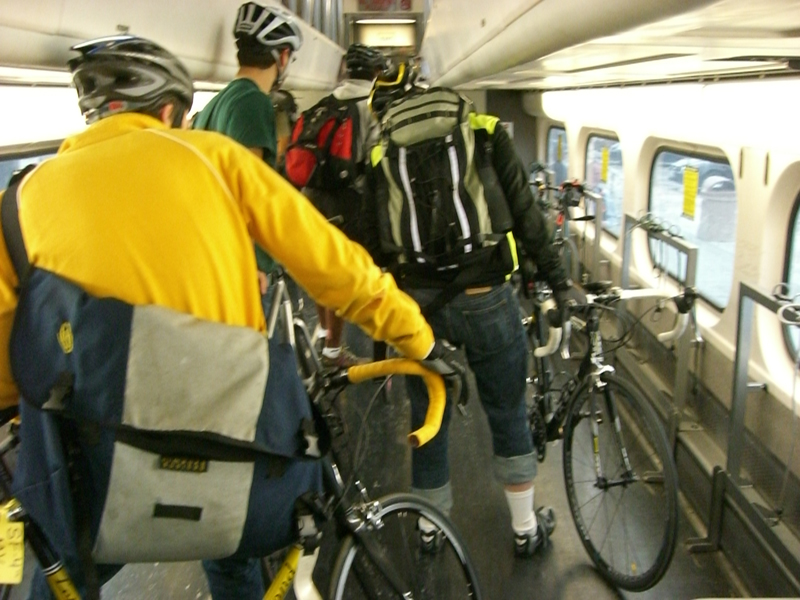 One One thing
you’ll catch on to quickly is the “orchestra” of movement and, daresay,
etiquette, that is critical for bike commuting.
One One thing
you’ll catch on to quickly is the “orchestra” of movement and, daresay,
etiquette, that is critical for bike commuting.
Essentially, folks are in a
hurry and they have this big thing they are lugging around. They have to get on
and off fast. Problem is, if your bike is behind another that isn’t getting off
on your stop, you are screwed. You need to somehow extricate your bike from the
rack. This creates a tension and sense of urgency that is primal in nature, and
it happens all at once. As a
result, certain rules have evolved; bikes need to be labeled with start/end
destinations so they can be sorted in the limited space of the racks. And
someone has to do the sorting of the bikes. But some
folks are clueless or just don’t care. This adds a lot of inordinate stress.
To compound things, unbelievably, on nighttime commutes, it's frequent that bikers are turned down
because the
racks are already too full. This is totally deflating; riders will have to wait
30-40 minutes for the next train and HOPE there will be room. What a total pain
in the rear. There has actually
been a groundswell to add more bike cars to Caltrain; in fact I saw two
representatives from SFbike.org
last week taking pictures and taking notes. They are advocating adding more train cars that have
bike “parking”. It’s a great idea and should be supported.

Once on the train, it's actually quite relaxing.
Most of the time I'd just go through the morning or evening email. On trips with
lots of stops, I'd dig into a book. I actually looked forward to the quiet/down
time that I don't have in the car. The thing you do get while driving, though,
is a chance to catch up with your friends via cell phone. Talking on the train
seems sort of uncool to me, though, and judging from most of my fellow
passengers, they were in agreement. This picture below shows the "essentials"--book, crackberry, backpack, sunglasses, and light. Most people also carry their ipod.
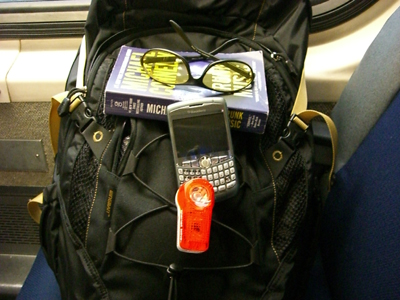 Don’t sweat it
Don’t sweat it
My first rule of thumb was to try
and commute without getting sweaty; to fight the competitive urge and ride slow. Heck, it seems in Europe that folks ride
their bikes all over the place without getting sweaty and smelly. Boy, was I
wrong. Commuting in traffic against a deadline plus the natural urge to race means one thing:
SWEAT. It turns out that commuter-cyclists are either very slow or damn fast.
One guy dropped me at 28+ mph and there was nothing I could do to catch up.
Another guy had fashioned a recumbent bike entirely by himself with carbon fiber
tubes and an electric motor. It was all I could do to try and stay in his draft.
In the end,
I found myself arriving at work with helmet-head and a soaked undershirt
and probably not too good-smelling. Finally I started wearing bike shorts and a coolmax shirt, packing my “dress clothes” for later
(though I did forget
underwear and a belt on different occasions)…Fortunately, we have showers at
work which make it easy to change.
The Return Trip
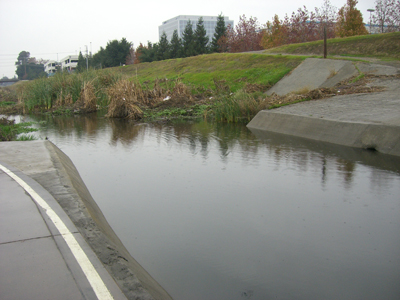
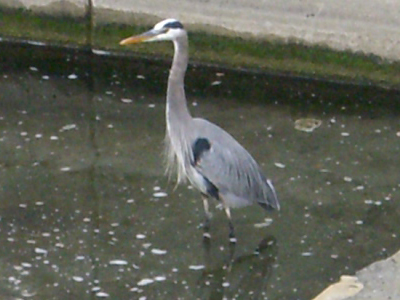 While I figured out how to ride to
work in relative comfort, riding home is always a challenge. I haven’t yet found
the time to change back in to the biking shorts (unless I wear them all day
under regular shorts), so I usually end up with street
clothes, including jeans. And, as per usual, I am typically late in leaving which means I have to
pedal extra fast to catch the train. I usually arrive "just in time" and
sweating like crazy.
While I figured out how to ride to
work in relative comfort, riding home is always a challenge. I haven’t yet found
the time to change back in to the biking shorts (unless I wear them all day
under regular shorts), so I usually end up with street
clothes, including jeans. And, as per usual, I am typically late in leaving which means I have to
pedal extra fast to catch the train. I usually arrive "just in time" and
sweating like crazy.
After mellowing out for a while once on the train, it's time to get off and
"do the climb" back home. This is the worst part about the whole commute. What’s left is
the daunting 3-mile ride back up to my house in the dark. There are 4 sections to climb.
The first 2 are ok. The third is scary with cars whizzing past inches away and
the fourth is “straight up”. I arrive at home wired yet exhausted and sweating
like a pig on a roast. Shower #2 (or 3) for the day…
Saddle Sore
When I first started, I used my
trusty old Selle Italia Gel saddle. Wow, without bike shorts, it leaves a lot to
be desired. I immediately bought some butt-cream but ultimately switched saddles
to the amazing
Fizik Aliante that is normally reserved for my race bike. After nearly a month, I have to say it’s been the best
thing for comfort on a bike. It really is an incredibly different and better
saddle.
Clothing
Dialing the correct clothing is always
important on a bike; you sweat a lot so the clothes have to breath. But it can
be cold, and though
fifty degrees may not seem THAT cold, here in the SF Bay, it’s pretty
uncomfortable with the wind chill.
The best morning wear seems to be a wind-proof but breathable shell with plenty
of ventilation zips. Under that, a simple synthetic layer. The larger challenge
is riding home; a freshly shut-down laptop tends to concentrate a boatload of
heat against your back, further heating up your core. Of course, it’s usually
pretty chilly when you first set out, but I found I’d heat up quickly and end up wearing just
a t-shirt with full fingered gloves to keep my hands warm. There are also
commuter-specific backpacks that suspend the contents away from your back and
help the sweat to evaporate. I finally threw down for a
CamelBack Wingman that has a
ventilated back area that helps with the heat but also has enough room for a
change of clothes. As for shoes—I wore the same shoes and socks on the bike as
well as at work. I didn’t have enough space to lug a second pair of cleated
cycling shoes.
Changing things
There is an adage in triathlon
racing—don’t ever try something new before a race. No new shoes or equipment
adjustments. Same is true for commuting. Why? Because in both cases you are in a
race against time and you need to depend on your gear. One day, I made the mistake of
switching seatposts the night before. The next day, once off the train, the seat kept sliding down.
So I stopped and
yarded on the seat pin a little too hard. *Ping*, it snapped. I was late for
a meeting and had to ride, low-rider style, with seat & post buried in the seat
tube. My knees hurt and the saddle was flipping left/right. Worse, I really
dinged up my once sweet carbon seat post. At lunch, I had to beg a ride to far
off bike shop to find a replacement Campy seat pin. Lesson learned.
Bike Equipment
In addition to a good jacket,
there are some other essentials. This includes a lock, fender for the rain,
durable tires, rear light, and headlight. You’ll also want a toolkit with spare
tube, pump, and a backup light. Here is what I chose:
- Lock: Trek cable lock that has a built in holder. Simple to use and, at around a pound, lighter than a kryptonite job.
- Fender: the first day I rode in the rain not owning a fender was a big mistake. I was in full “dress clothes” and ended up cold with a wet butt that ended up caked with dirt and grit. I headed to the nearest LBS and got an inexpensive Headland fender; it does a fine job.
- Tires: Conti Grand Prix 4-seasons in 700x25. These are awesome tires; still relatively light (220 grams) but with a supple ride that’s made more cushy by the 25mm width. So far, bomb proof.
- Rear Light: I use two Planet Bike Super Flash red lights; one on the bike and one on my backpack. They are amazingly bright, cheap (at $20), and last forever on the included batteries.
- Front Light: I tried using a $40 Cateye Opticube up front but it was a waste of money; the lighting just isn’t enough to light up the road. I upgraded to a NiteRider MiNewt USB for $80 instead. Much brighter, crisper white light. Plus it charges via a laptop-usb connection or traditional plug and runs for 3 ½ hours. Your safety is worth the extra $40! (If you are looking for a bike light, check out the incredible coverage on bike lighting here on mtbr.com.) Speaking of the backup light—I was heading home on a Friday night. Got to the station and they said the train would be delayed 30 minutes. What the heck, I thought, I’ll just ride. By 5:45, it was pretty damn dark and by 6, I could see my breath. Worse still, I had forgotten to charge the MiNewt and it was out of gas. Luckily I had a backup LED headlamp which helped get me to a store where, um, my wife picked me up.
Bike Setup
I used my trusty 1986 Nishiki
International. It has large diameter steel tubes that provide an amazingly
comfortable ride. Yet the old steed is still plenty stiff with no chain rub
while out of the saddle.
The components are a complete mishmash including:

- New used 9-speed 105 rear derailleur
- 8-speed era Ultegra front derailleur
- 8-speed era Dura Ace square spindle bottom bracket and cranks with 53/39 rings
- 9-speed era Ultegra shifters/brake levers
- 11-25 Ultegra 9-speed cassette created by using pieces from a 12-25 and 11-23 cassette
- '86 Campy Record front hub with 36 spoke Mavic Open Pro blue rim; Ultegra rear hub with same rim.
- 1988 era carbon-wrapped seat post from Nytro Sports
- Mavic brakes
- Beartrap pedals with straps; 300 grams each!
- Ritchey Biomax bars which are perfect for commuting; shallow drop and very stiff
- Supergo upright stem to make it easier to sit up and steer. When you are "wearing a laptop", it's more comfy to be upright.
- New Reynolds 1” carbon fork to smooth out the bumps up front
What’s
really remarkable with this rig is the shifting is FLAWLESS.
Good old Shimano really knows how
to dial in backwards compatibility!
Fully loaded, the old steed weighs over 24 1/2
pounds (nearly 10 pounds heavier than my Cervelo R3) but still provides a fairly supple
yet responsive ride that smooths out the bumps and reduces fatigue.
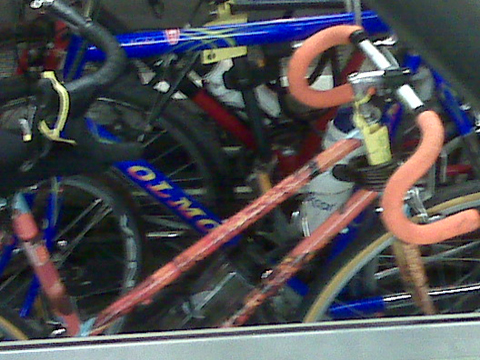 The bikes!
The bikes!
To be a good commuter bike, it has to be rock-solid and
dependable because it will take a lot of abuse being banged around on the train
(with up to 3 other bikes leaning on it) plus dealing with the elements. Most
impressive in this experience was checking out the bikes on the train. There was
the full range of high end race bikes (Parlees, Look 585s, Eddy Merckx) as well
as single speeds, Schwinn Varsitys, 29ers, mountain bikes, and everything in
between. Check out the crazy orange rig on the left with backwards facing drop
bars!
I’d encourage commuters to post pics of their favorite rigs here on roadbikerview.com!
Summary
It's awesome that mass transit plus pedal power is a viable solution to getting
around the Bay Area. I must admit that I looked forward to the adventure every
day. I also upped my normal 50 mile per week cycling average to around 100. It
paid off in stronger weekend "pleasure" rides and I was able to climb with less
effort. I'll be commuting like this in the Spring
and Summer more frequently (when there is more daylight!) to get in shape for
triathlons for sure.
For more on commuting, check out Roadbikereview's forums located here.